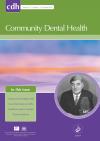Community Dental Health

- Cover Date:
- December 2016
- Print ISSN:
- 0265 539X
- Vol:
- 33
- Issue:
- 4
Dental problems and Familismo: social network discussion of oral health issues among adults of Mexican origin living in the Midwest United States
Objective: To examine the influence of collectivist orientation (often called familismo when applied to the Latino sub-group in the United States) in oral health discussion networks. Basic Research Design: Through respondent-driven sampling and face-to-face interviews, we identified respondents’ (egos) personal social network members (alters). Egos stated whom they talked with about oral health, and how often they discussed dental problems in the preceding 12 months. Participants: An urban community of adult Mexican-American immigrants in the Midwest United States. We interviewed 332 egos (90% born in Mexico); egos named an average of 3.9 alters in their networks, 1,299 in total. Method: We applied egocentric network methods to examine the ego, alter, and network variables that characterize health
discussion networks. Results: Kin were most often leveraged when dental problems arose; egos relied on individuals whom they perceive to have better knowledge about dental matters. However, reliance on knowledgeable alters decreased among egos with greater behavioural acculturation. Conclusions: This paper developed a network-based conceptualization of familismo. We describe the structure of oral health networks, including kin, fictive kin, peers, and health professionals, and examine how networks and acculturation help shape oral health among these Mexican-Americans.
Key words: network science, social network analysis, familismo, collectivism, dental health, Mexican immigrants, Mexican-American
doi:10.1922/CDH_3946Maupome06
- Article Price
- £15.00
- Institution Article Price
- £
- Page Start
- 303
- Page End
- 308
- Authors
- G. Maupome, W.R. McConnell, B.L. Perry
Articles from this issue
- Title
- Pg. Start
- Pg. End
- An intervention study to assess the effectiveness of a reminder telephone call in improving patient appointment attendance at a Community Dental Service clinic
- 239
- 241
- Patient characteristics in relation to dental care payment model: capitation vs fee for service
- 252
- 256
- Psychometric properties of the English version of the Oral Health Literacy Adults Questionnaire - OHL-AQ
- 274
- 280
- Approximal caries increment in relation to baseline approximal caries prevalence among adolescents in Sweden with and without a school-based fluoride varnish programme
- 281
- 285
- Variation in methods used to determine national mean DMFT scores for 12-year-old children in European countries
- 286
- 291
- The relationship between maternal smoking during pregnancy and parental-reported experience of dental caries in Indigenous Australian children
- 297
- 302
- Dental problems and Familismo: social network discussion of oral health issues among adults of Mexican origin living in the Midwest United States
- 303
- 308
